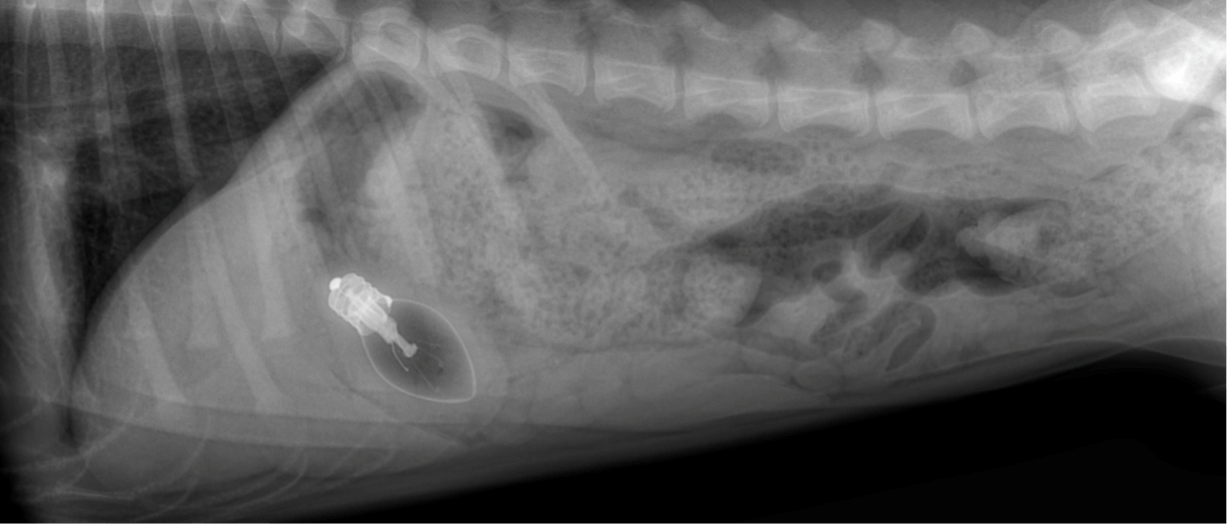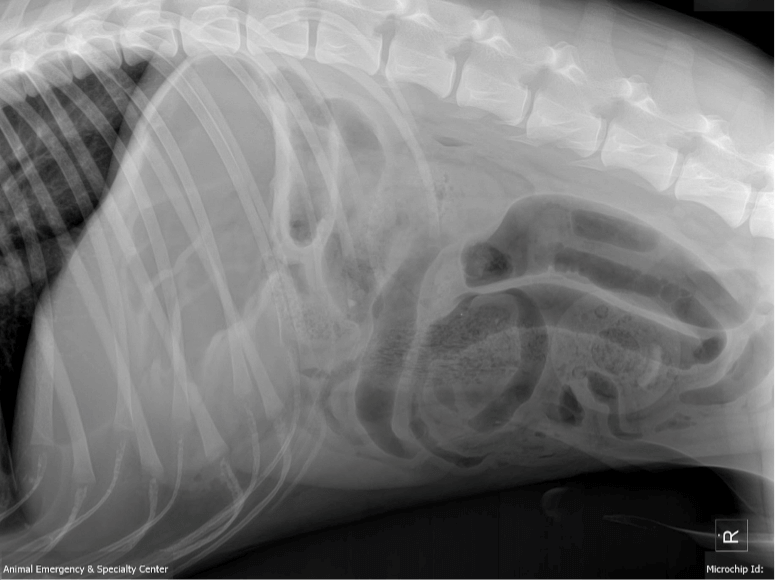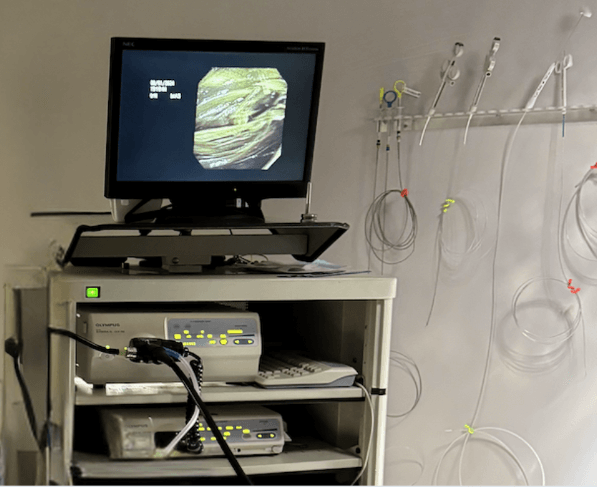Oct 22, 2024
By: Kimberly Hassen DVM DACVAA
Although socks, toys, towels, and corn cobs are the most common foreign bodies we see, the possibilities are truly endless:
Let's face it: dogs and cats don't always eat things that are technically "edible." From socks to rocks, these indigestible objects, referred to as "foreign bodies," can get lodged in the digestive tract. Then, ingested food material gets stuck behind the foreign body, which becomes a medical emergency.
Some pets will try to ingest a foreign body in front of their owners. Other times, pets leave evidence of foreign body ingestion, such as a partially chewed up toy, for their owner to find after the fact. There is also the possibility that a pet ingested a foreign body without any witnesses or evidence.
Dirty socks are often a canine favorite, whereas hair ties and thread are hits with cats. Typically, younger pets are the biggest offenders, but some pets wait several years before trying to eat indigestible objects. Occasionally, pets will scarf down indigestible objects after starting medications that dramatically increase appetite. Older pets may develop masses or tumors in their intestines that can block the normal flow of food and water. No matter the cause of the blockage, the symptoms are generally similar.
If you know or suspect your pet has ingested a foreign body, or your pet is showing any of the above signs, seek veterinary care immediately.
History: First, the veterinary team will ask you some questions. This process is known as taking a “history.” They will want to know whether foreign body ingestion is witnessed or suspected, if your pet has ingested a foreign body before, and if your pet is showing signs of foreign body ingestion such as vomiting, diarrhea, lethargy, lack of appetite, or any other unusual behavior.
Physical Exam: The veterinarian will examine your pet from head to tail. When (usually) cats ingest thread or string, part of it may wrap around the base of the tongue, and so an oral exam is an important part of this process. The exam will also focus on the belly to look for pain or any other signs that could indicate a intestinal blockage.
Diagnostic imaging: After the exam, the veterinarian will likely recommend diagnostic imaging. Usually this includes x-rays and/or ultrasound to look at the intestines themselves. Some foreign bodies, like rocks, are easy to see on x-rays. Others blend in with partially digested food. Intestinal blockages may show a characteristic pattern, but ultrasound can be a more sensitive test for less obvious cases.

X-ray: Light bulb in the stomach

X-Ray: BBQ skewer spanning from the esophagus to the stomach

X-Ray: Can you find the pacifier?
Blood tests: The symptoms of foreign body ingestion, like vomiting, diarrhea, and lack of appetite, can cause electrolyte imbalances that can be detected with a simple blood test. Blood testing also helps rule out other causes of the symptoms. (Not every vomiting pet has a foreign body.) Finally, blood testing helps tell the veterinarian about your pet’s liver and kidney health, which is important should your pet require general anesthesia for endoscopic or surgical removal of a foreign body.
Induce vomiting: If your pet ingested the object in question within 1-2 hours prior to the exam, the veterinarian may be able to make your pet vomit with special medication to bring up the foreign body before it can obstruct the digestive tract. If x-rays show a foreign object in the stomach, this may be recommended. However, if the object is sharp, corrosive, or particularly large, vomiting may not be recommended. This is to avoid damage to or blockage of the esophagus.
Endoscopy: Endoscopy is another way to remove the foreign body if it is in the upper digestive tract – the esophagus or stomach. In this procedure, a flexible tube and camera are inserted down the esophagus and stomach. Special tools follow to grip and remove the foreign body. Foreign bodies easily removed via endoscope include hair ties, rocks, and pet toys. Endoscopy is often a short procedure but requires general anesthesia. Pets undergoing endoscopy can usually go home within a few hours after the procedure.

On the left: Endoscopy tower showing blades of grass in a dog’s stomach.
On the right: Instruments used for retrieving various inedible objects or taking biopsies of the stomach and intestines.
Surgery: If a foreign body is too large, sharp, or it has passed through the stomach and into the intestines, surgical removal is recommended. With surgery, an incision is made into the abdomen to physically remove the object from the stomach (gastrotomy) or the intestines (enterotomy). In more severe cases, the foreign body blockage damages the intestines enough that part of them need to be removed, and the remaining healthier intestines are stitched back together. This procedure is called resection and anastomosis. Pets undergoing foreign body removal surgery are recommended to stay in the hospital at least overnight, but up to several days depending on the severity of the blockage, degree of intestinal damage, and physical condition of the pet.
IV fluids and time: In some cases, foreign bodies can pass through the intestinal tract without causing a blockage. Success depends on the size of the object, the size of the pet, and the pet’s level of hydration. In special cases, if the object has made it almost all the way through the intestines, several hours of intravenous fluid therapy may lubricate the intestines enough that the foreign body passes on its own.
Intestinal leakage (dehiscence): This is the most serious risk of foreign body removal surgery. If intestines leak their contents freely into the abdomen, life-threatening infection (sepsis) occurs. The risk is approximately 3% if the intestines must be opened during surgery, and the risk is greatest 3-5 days after surgery. Should this complication occur, another surgical procedure is necessary to close the leakage.
Opening of the skin incision: This is when the stitches fail to keep the incision closed before the body heals itself. Exercise restriction for two weeks after surgery prevents tugging at/opening the surgery incision before it’s healed.
Skin infection: Pets that are wearing an appropriately-sized Elizabethan collar (cone) are prevented from licking their surgical incision, which greatly reduces the risk for skin infection.
Negative explore: A negative explore occurs when an abdominal incision is made, but no additional intervention is indicated. This may happen if between diagnostic imaging and surgery, the foreign body makes its way through the small intestine to the colon. If the foreign body reaches the colon, we recognize that the foreign body will be able to pass naturally and opening the intestines is not recommended. Rarely, because diagnostic imaging is not perfect, what was thought to be a foreign body was merely food. Although technically no procedure occurs during a negative explore, the abdominal organs are thoroughly evaluated, and the abdominal incision is closed. Appropriate aftercare, including exercise restriction and preventing the pet from licking the incision, is still necessary.
Anesthesia: Veterinary medicine has advanced markedly in recent years, enabling us to provide expert-level anesthetic care. Still, anesthesia inherently carries risks, including inhalation of gastric contents into the lungs (a serious condition known as aspiration pneumonia), kidney injury, and death. Recently published anesthesia mortality rates in dogs and cats are less than 2%.
Many pets feel better after surgery once food material can flow normally through the intestines again. However, the foreign body may have irritated the intestines prior to its removal, causing persistent nausea, loss of appetite, and regurgitation of food or fluid. Inflammation within the digestive tract can affect the pancreas, causing pancreatitis. The early postoperative period is critical for rehydration and monitoring. Pets may not eat or defecate normally during this time. Depending on the severity of the intestinal damage, the early recovery period may last from one day to a week or more.
The longer a foreign body stays in a pet’s digestive tract, the more damage it can cause. Repeated vomiting leads to dehydration, electrolyte imbalances, and aspiration pneumonia. An untreated intestinal blockage can cause perforation and life-threatening infection. That is why it is important to seek veterinary care as soon as possible if you know or suspect that your pet has ingested a foreign body.
AESC is open 24/7/365 for emergency care. In addition, our board-certified specialists collaborate to provide the best care possible for our patients. Our board-certified radiologists provide expert interpretation of x-rays and ultrasound to accurately recognize when emergency intervention is necessary. Our internal medicine specialists are trained in endoscopy for when non-surgical foreign body removal is indicated. Our board-certified surgeons are on-call – day and night – should emergency surgery be necessary. At AESC, we take pain management seriously. We administer local numbing agents and systemic pain medications to help pets feel their best after surgery. Pre- and postoperatively, our emergency and critical care teams prevent and treat nausea, vomiting, and fluid and electrolyte imbalances that come with more severe foreign body ingestion cases.
The best way to prevent foreign body-induced intestinal blockage is to limit pets’ access to non-food materials that they may be tempted to eat.